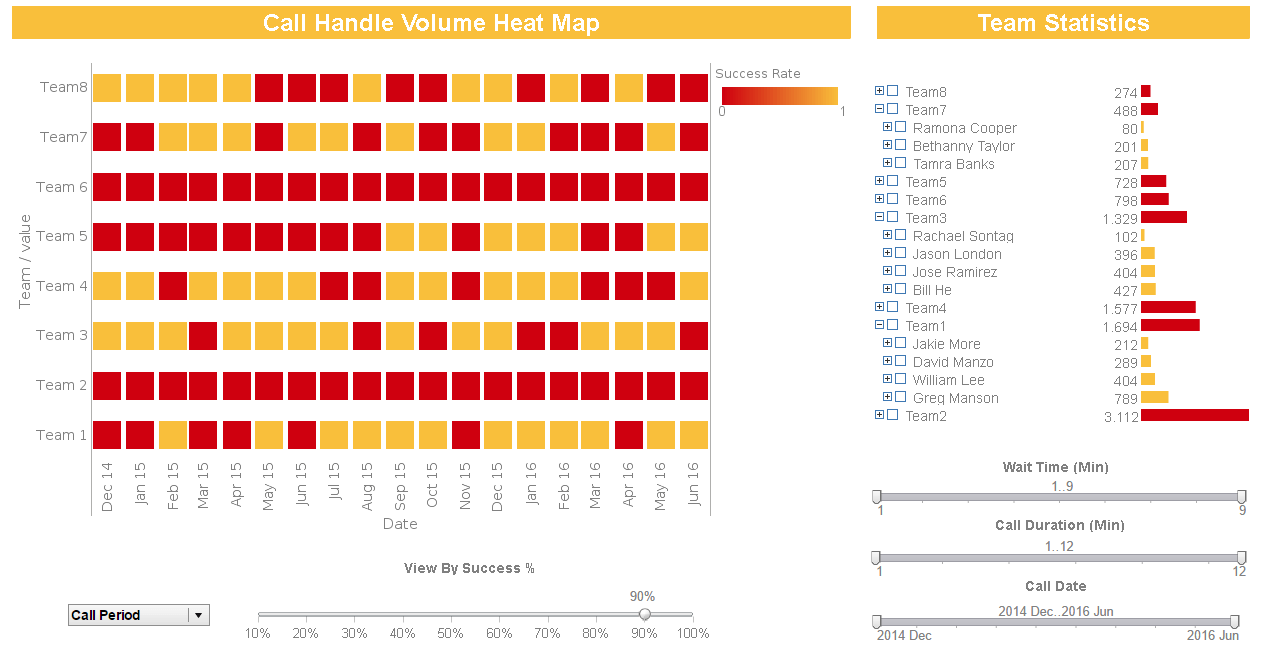Increasing Call Center Performance
Below is the continuation of a transcript of a Webinar hosted by InetSoft on the topic of "Performance Management in Government." The presenter is Christopher Wren, Principal Consultant at GPM.
Christopher Wren (CR): So the one tip is to rethink benchmarking, and the next tip is to spend right. In other words, let’s not overspend in some areas. A third would be summarized by this phrase “too simple to be accurate.” What we are talking about here is the common perception that any increase in performance in something like a phone system or a call center or any other output which would be represented on that horizontal axis on the bottom of the chart is good.
Any increase in service level will lead to an increase in outcomes. If we answer the phone more quickly, people will be happier. If we respond by mail in nine days instead of 10 days, that’s better. You know what? That’s not necessarily true. This very straight diagonal relationship we estimate on this chart is simply inaccurate. Let me show you what’s the real connection between driver change and expected change in outcomes.
You can see in the real world, you get a bump, and you can see that bump at about 75 where yes, if I answer the phone call in nine minutes instead of 10 minutes, people will be happier. But what if I spend extra money to bring that down to 8 minutes or 7 minutes it may not be worth the money because there may not be a correlation beyond a certain point between my service levels and changes in outcome.
So spending money in this case with these numbers on the bottom of the chart spending the extra money to go from 80 to 85 clearly isn’t worth it. It really doesn’t help you. So think about your correlation, your connections between expected change in outcome and service level, and if you have been just kind of going along with the notion that any change in service level is helpful and that any investment in service levels are worthwhile, that may not be actually true.
But let me show you some real examples of this. This is a state government call center and you can see here they are measuring percentage of calls abandoned while in queue at the call center. So in another words how many people are hanging up the phone? Currently they had about 10% of the people hanging up the phone. Well some day an executive came in and said, you know what, we have got to cut that in half. We have got to go from 10% to 5%.
Well, you know they looked at it again, and they knew that’s going to be very expensive. We are going to have to hire a lot more operators, we will have to invest in a new call center. Then we looked at it with this correlation and did an evaluation and said, you know what, getting to about 6.6% is probably good enough because beyond that additional spending to bring that number down had no change, no change in outcome. So again any additional spending from about 6.6% to 5% will be waste of money. You don’t really need to get down that low, so this belief that we have to somehow get a zero calls abandoned or a 100% success rate, that’s not necessarily true.
Striking a Balance
Balancing a zero abandonment rate with cost efficiency at a call center involves navigating a delicate trade-off between providing exceptional customer service and managing operational expenses effectively. On one hand, achieving a zero abandonment rate implies prioritizing customer satisfaction by ensuring that every call is answered promptly and resolved satisfactorily. This approach can enhance customer loyalty, retention, and brand reputation, as customers feel valued and supported when their inquiries are addressed in a timely manner. However, maintaining such a high level of service may require significant investments in staffing, technology, and training to handle peak call volumes and minimize wait times, thereby increasing operational costs for the call center.
On the other hand, optimizing for cost efficiency involves implementing strategies to streamline operations, reduce overhead, and maximize resource utilization within the call center. This may entail adopting workforce management techniques to schedule agents efficiently, implementing self-service options and automated processes to handle routine inquiries, and outsourcing certain functions to lower-cost locations or service providers. While these measures can help control expenses and improve operational efficiency, they may also result in longer wait times, increased call abandonment rates, and reduced customer satisfaction levels, as customers may experience delays or difficulties in reaching a live agent or obtaining timely assistance.
Finding the right balance between a zero abandonment rate and cost efficiency requires call center managers to consider various factors, including customer expectations, service level agreements, budget constraints, and business priorities. By adopting a data-driven approach and leveraging performance metrics such as average speed of answer, abandonment rate, customer satisfaction scores, and cost per call, managers can assess the trade-offs between service quality and cost-effectiveness and make informed decisions to optimize call center operations. Ultimately, striking the right balance involves continuously monitoring performance, refining processes, and adapting strategies to meet evolving customer needs while maximizing operational efficiency and cost-effectiveness.


